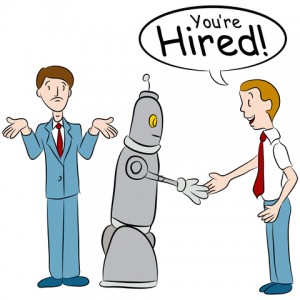 Can this picture become a reality for the translation and interpretation industry?
Can this picture become a reality for the translation and interpretation industry?
As interpreters, we are always interested in the development of interpretation technology, including the possibility of “robot” interpreters. About a year ago, we wrote about the potential of interpretation software and Microsoft’s efforts in that area. Their software is meant to analyze your speech, translate it and synthesize an audio track of your own voice speaking in the target language. (However, the software will first need to study your voice for several hours. Also, it gets around one in eight words wrong.)
So are there robot interpreters in our future? The answer is complicated. Perhaps one day, but not any time soon.
Interpretation software faces many difficulties, in each of its component stages. The first step is speech recognition, an area that has seen great improvement over the last few years. Nowadays, speech recognition figures in our daily lives – when we make a call and are asked to speak to a robot, when we are driving and asked to give commands to the stereo system, etc. Due to its wide range of applications, speech recognition is the most mature of the technologies involved, but even it still has a long way to go before it becomes truly reliable, as we are well aware from our experiences.
Next, the words spoken (and hopefully understood correctly by the system) need to be translated. While machine translation has certainly come a long way, anyone who has tried to use Google or Bing Translate on a foreign language website can testify that what comes out is not always even legible, much less an accurate translation of the source text.
Finally, the software needs to generate a spoken version of its translation through text to speech synthesis. This is possible with today’s technology, but even there many irregularities remain. Intonation, emphasis and other vocal indicators still do not carry over particularly well into artificial voice generators, creating voices that sound, well, robotic.
Beyond these basic limitations of the software, there also remain concerns about the nuances of both translation and interpretation. Questions about homonyms, about words that have multiple meanings depending on context, and of course the issue of cultural differences. There are many situations where even the most sophisticated software will be unable to guess the subtle nuances a speaker intends. A human interpreter does not just translate the words, but also the subtext and hidden meanings within them, judging not only the speaker, but also the audience.
“Reading the audience” to judge their understanding and reception of the translation is a vital skill for an interpreter. It is also one that becomes even more important in smaller, more intimate settings outside of presentations and conference interpretation. In a business meeting, at a doctor’s appointment, even in court, the message needs to be tailored based on the reactions of the listener.
Can you image a robot, as they as now, doing medical interpretation or legal interpretation?
Monterey Language Services strives to provide the highest quality of translation and interpretation services. Please feel free to contact us for a quote.




Leave Your Comments Below